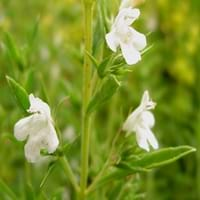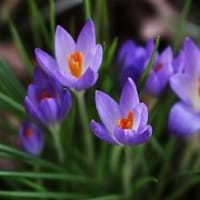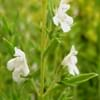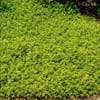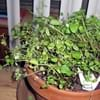Life Span
Perennial
Perennial
Type
Herbs
Bulb, Flowering Plants
Origin
Europe, Southern Europe
Aegean Islands, Central Asia, Middle East, North Africa, Southern Europe, Western China
Types
Not Available
Crocus abantensis, Crocus adanensis, Crocus biflorus, Crocus chrysanthus, Crocus korolkowii
Number of Varieties
Not Available
Habitat
All sorts of environments
Scrubs, Woods
USDA Hardiness Zone
6-9
3-8
Sunset Zone
3a, 3b, 4, 5, 6, 7, 8, 9, 10, 11, 14, 15, 16, 17, 18, 19, 20, 21, 22, 23, 24
1a, 1b, 2a, 2b, 3a, 3b, 4, 5, 6, 7, 8, 9, 10, 11, 12, 13, 14, 15, 16, 17, 18, 19, 20, 21, 22, 23, 24
Habit
Clump-Forming
Clump-Forming
Minimum Height
Not Available
Flower Color
White, Pink, Lavender
Blue, Orange, Pink, Purple, White, Yellow
Flower Color Modifier
Bicolor
Not Available
Fruit Color
Not Available
Not Available
Leaf Color in Spring
Green, Gray Green
Green
Leaf Color in Summer
Green, Gray Green
Not Available
Leaf Color in Fall
Green, Gray Green
Green
Leaf Color in Winter
Light Green
Green
Leaf Shape
Lanceolate to elliptical
Grass like
Plant Season
Spring, Summer, Fall, Winter
Spring, Winter
Sunlight
Full Sun
Full Sun, Part sun
Type of Soil
Loam, Sand
Loamy
The pH of Soil
Neutral, Alkaline
Neutral, Slightly Acidic
Soil Drainage
Well drained
Well drained
Bloom Time
Early Summer, Summer, Late Summer
Spring, Winter
Tolerances
Drought
Drought
Where to Plant?
Container, Ground, Pot
Container, Ground, Pot
How to Plant?
Seedlings, Stem Cutting
From bulbs, Grafting, Seedlings
Plant Maintenance
Medium
Medium
Watering Requirements
Average Water Needs, Keep the Soil well drained
Form a Soil ring to water efficiently, Water Deeply, Water twice a day in the initial period, Water when soil is dry
In Summer
Lots of watering
Lots of watering
In Spring
Moderate
Moderate
In Winter
Average Water
Average Water
Soil pH
Neutral, Alkaline
Neutral, Slightly Acidic
Soil Type
Loam, Sand
Loamy
Soil Drainage Capacity
Well drained
Well drained
Sun Exposure
Full Sun
Full Sun, Part sun
Pruning
In Early Autumn, Remove damaged leaves, Remove dead branches, Remove dead leaves
No pruning needed in the early stages, Prune to stimulate growth, Remove dead or diseased plant parts, Requires little pruning
Fertilizers
All-Purpose Liquid Fertilizer, Doesn't require fertilization when grown in rich soil
All-Purpose Liquid Fertilizer
Pests and Diseases
Free of serious pests and diseases
Aphids, Botrytis Blight, Mushroom root rot, Narcissus Basal Rot, Narcissus Bulb Fly, Slugs, Snails, Tulip Fire, Tulip Viruses
Plant Tolerance
Drought
Drought
Flower Petal Number
Single
Single
Fragrant Bark/Stem
Yes
No
Foliage Texture
Fine
Fine
Foliage Sheen
Matte
Glossy
Attracts
Butterflies
Not Available
Allergy
Unknown
Not Available
Aesthetic Uses
Farmland, Wild gardens
Not Used For Aesthetic Purpose
Beauty Benefits
Not Available
Not Available
Environmental Uses
Air purification
Air purification
Medicinal Uses
Cramps, Diarrhea, Indigestion, Sore throat
Arthritis, Gout
Part of Plant Used
Dried seeds, Flower Stalk, Flowering Tips, Flowers, Leaf Stalks, Leaves, Twigs
Whole plant
Other Uses
Condiment, Used in flavouring curries, teas
Not Available
Used As Indoor Plant
No
No
Used As Outdoor Plant
Yes
Yes
Garden Design
Container, Edging, Edible, Herb / Vegetable, Mixed Border, Rock Garden / Wall
Not Available
Botanical Name
SATUREJA montana
Crocus Longiflorus
Common Name
Winter Savory
Crocus
In Hindi
Winter Savory
Crocus
In German
Winter-Bohnenkraut
Krokus
In French
Winter Savory
Crocus
In Spanish
Satureja montana
Azafrán
In Greek
Satureja montana
κρόκος
In Portuguese
Segurelha-das-montanhas
Açafrão
In Polish
Cząber górski
Krokus
In Latin
winter savory
Erocum
Phylum
Magnoliophyta
Magnoliophyta
Class
Magnoliopsida
Liliopsida
Order
Lamiales
Asparagales
Family
Lamiaceae
Iridaceae
Clade
Angiosperms, Asterids, Eudicots
Angiosperms, Monocots
Tribe
Not Available
Not Available
Subfamily
Not Available
Crocoideae
Number of Species
Not Available
Importance of Winter Savory and Crocus
Want to have the most appropriate plant for your garden? You might want to know the importance of Winter Savory and Crocus. Basically, these two plants vary in many aspects. Compare Winter Savory and Crocus as they differ in many characteristics such as their life, care, benefits, facts, etc. Every gardener must at least have the slightest clue about the plants he wants to plant in his garden. Compare their benefits, which differ in many ways like facts and uses. The medicinal use of Winter Savory is Cramps, Diarrhea, Indigestion and Sore throat whereas of Crocus is Arthritis and Gout. Winter Savory has beauty benefits as follows: Not Available while Crocus has beauty benefits as follows: Not Available.
Compare Facts of Winter Savory vs Crocus
How to choose the best garden plant for your garden depending upon its facts? Here garden plant comparison will help you to solve this query. Compare the facts of Winter Savory vs Crocus and know which one to choose. As garden plants have benefits and other uses, allergy is also a major drawback of plants for some people. Allergic reactions of Winter Savory are Unknown whereas of Crocus have Not Available respectively. Having a fruit bearing plant in your garden can be a plus point of your garden. Winter Savory has no showy fruits and Crocus has no showy fruits. Also Winter Savory is not flowering and Crocus is flowering. You can compare Winter Savory and Crocus facts and facts of other plants too.
